
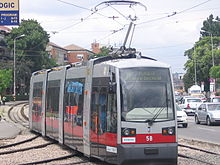
The Ultra Low Floor tram (ULF) is a low-floor tram operating in Vienna, Austria, and Oradea, Romania, built by a consortium composed of Siemens and ELIN in Vienna. It has the lowest floor-height of any such vehicle.


The Ultra Low Floor tram (ULF) is a low-floor tram operating in Vienna, Austria, and Oradea, Romania, built by a consortium composed of Siemens and ELIN in Vienna. It has the lowest floor-height of any such vehicle.

In contrast to other low-floor trams, the floor in the interior of ULF is at sidewalk height (about 20 cm or 7.9 inches above the road surface), which makes access to trams easy for passengers in wheelchairs or with baby carriages. This configuration required a new undercarriage. The axles had to be replaced by a complex electronic steering of the traction motors. Auxiliary devices are installed largely under the car's roof.
The ULF technology went into testing in the early 1990s. Since 1998, ULFs have been in use on Vienna's tram network. As of mid-2008, 302 cars were in operation (150 cars since mid-2006, and another 152 as of 2007).
Siemens ULF trams were introduced in Oradea, Romania, on 24 April 2008, and are the only ULF trams outside Austria. [1]
| City / Operator | Type designation | Built in | Number of vehicles | Length | Width | Weight (empty) | Maximum power |
|---|---|---|---|---|---|---|---|
| Vienna / Wiener Linien | A | 1995 (prototype), 1997 | 50 | 24.2 m (79 ft 4+3⁄4 in) | 2.4 m (7 ft 10+1⁄2 in) | 30 t (29.5 long tons; 33.1 short tons) | 6 × 60 kW (80 hp) |
| A1 | 2007–2015 | 80 | 6 × 36 kW (48 hp) | ||||
| B | 1995 (prototype), 1998 | 100 | 35.3 m (115 ft 9+3⁄4 in) | 43 t (42.3 long tons; 47.4 short tons) | 8 × 60 kW (80 hp) | ||
| B1 | 2009-2015 | 100 | 8 × 36 kW (48 hp) | ||||
| Oradea / OTL | A1 | 2008–2009 | 10 | 24.2 m (79 ft 4+3⁄4 in) | 30 t (29.5 long tons; 33.1 short tons) | 6 × 36 kW (48 hp) |

A railcar is a self-propelled railway vehicle designed to transport passengers. The term "railcar" is usually used in reference to a train consisting of a single coach, with a driver's cab at one or both ends. Some railway companies, such as the Great Western, termed such vehicles "railmotors".
Transport in Oradea is provided by a network of public transport operating trams and buses, as well as roads. Tram and bus services are run by Oradea Transport Local S.A..

The Alstom Citadis is a family of low-floor trams and light rail vehicles built by Alstom. As of 2017, over 2,300 Citadis trams have been sold and 1,800 tramways are in revenue service throughout the world, with operations in all six inhabited continents. An evolution of Alstom's earlier TFS vehicle, most Citadis vehicles are made in Alstom's factories in La Rochelle, Reichshoffen and Valenciennes, France, and in Barcelona, Spain, and Annaba, Algeria.

The Siemens–Duewag U2 is a type of light rail vehicle (LRV), built by consortium of Siemens, Duewag and Wegmann & Co built between 1968 and 1990.

The Siemens Combino is a low-floor tram produced by Siemens Mobility. The first prototype was produced in 1996 at the Duewag works in Düsseldorf; the trams are now made in Krefeld-Uerdingen.
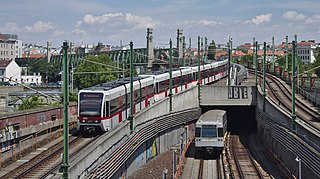
The Vienna U-Bahn, where U-Bahn is an abbreviation of the German term Untergrundbahn, is a rapid transit system serving Vienna, Austria. The five-line network consists of 83.1 kilometers of route, serving 109 stations. It is the backbone of one of the best performing public transport systems worldwide according to UITP in June 2009. More than 1.3 million passengers rode the Vienna U-Bahn every day in 2009, and 567.6 million passengers used the U-Bahn in 2011, which declined to 428.8 million passengers in 2013. The network is undergoing expansion and rolling stock renewal. Since 1969, 200 million euros have been invested annually in the extension of the Vienna U-Bahn.

The Siemens Avenio is a low floor tram family produced by Siemens Mobility, a subsidiary of the German conglomerate Siemens. It is the successor to the Combino family. The first generation was sold as the Combino Supra, Combino MkII, or Combino Plus. With the introduction of the second generation in 2009 the Combino brand was dropped and Siemens have referred to Combino Plus trams in Almada (Portugal) and Budapest (Hungary) as part of the Avenio range.

A low-floor tram is a tram that has no stairsteps between one or more entrances and part or all of the passenger cabin. The low-floor design improves the accessibility of the tram for the public, and also may provide larger windows and more airspace.

The Siemens S70; its successor, the S700; and European variant, the Avanto; are a series of low-floor light-rail vehicles (LRV) and streetcars manufactured by Siemens Mobility, a division of German conglomerate Siemens AG.
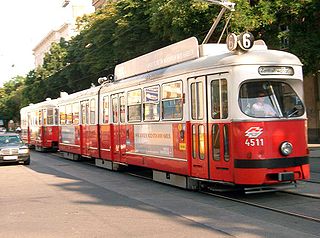
Simmering-Graz-Pauker AG (SGP), founded as Simmering-Graz-Pauker AG für Maschinen-, Kessel- und Waggonbau, was an important Austrian machine and engine factory, manufacturing: machinery, boilers and rail vehicles. It was established in 1941 through the merger of Simmering machinery and rolling stock company with the Graz machine and rolling stock company and the Paukerwerkstraße Corporation from Vienna. It was separated in 1989 into two divisions; SGP-VA Energie- und Umwelttechnik for power systems and SGP Verkehrstechnik for rail vehicles. The former became part of the Austrian Industries Technologies company and later became Austrian Energy & Environment, while the rail business was acquired by Siemens in the 1990s. It traded as Siemens SGP Verkehrstechnik before being fully merged into Siemens Austria in 2009.

The ADtranz low floor tram was introduced in the 1990s as the world's first tram with a completely low floor design. This tram was developed by MAN for the Bremen urban transport system. The prototype, tram number 3801, was first publicly introduced on 9 February 1990. From 1991 to 1993, it was being tested in many European cities. Ten German cities have purchased this type. Adtranz took over the rail division of MAN in 1990.
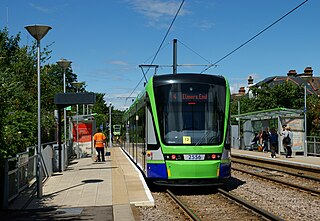
The Stadler Variobahn is a German-designed model of articulated low-floor tram and light rail vehicle. Since its introduction in 1993, the Variobahn has been manufactured variously by ABB, Adtranz, Bombardier Transportation, and since 2001 by Stadler Rail. As of 2009, 254 trams have been ordered, with an additional 110 on option. A unit costs about €2.5 million.

Railjet is a high-speed rail service in Europe operated by Austrian Federal Railways (ÖBB) and Czech Railways (ČD). Branded as Railjet Express (RJX) for the fastest services and as Railjet (RJ) for services with additional stops, it was introduced in 2008 and operates at speeds of up to 230 km/h (143 mph). Railjet is ÖBB's premier service and operates both domestically within Austria and on international services to adjacent major cities in the Czech Republic, Germany, Switzerland, Italy, Hungary and Slovakia.
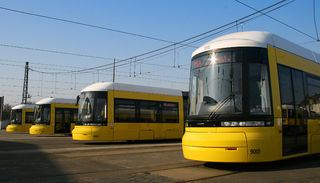
The Bombardier Flexity Berlin is a tram type constructed for the Berlin tramway network. It was developed by Bombardier Transportation during the late 2000s and is based on the Bombardier Flexity family of 100% low-floor trams.

The Munich tramway is the tramway network for the city of Munich in Germany. Today it is operated by the municipally owned Münchner Verkehrsgesellschaft and is known officially and colloquially as the Tram. Previous operators have included Société Anonyme des Tramways de Munich, the Münchner Trambahn-Aktiengesellschaft, the Städtische Straßenbahnen and the Straßenbahn München.

The Kraków tram system is a tram system in Kraków, Poland. The tramway has been in operation since 1882, and is currently operated by Miejskie Przedsiębiorstwo Komunikacyjne w Krakowie. There are 22 ordinary, 2 fast, and 3 night tram lines with a total line length of 347 kilometres (216 mi). As of 2013, the total route length of the tramway was 90 kilometres (56 mi), including a 1.4-kilometre (0.87 mi) tram tunnel with two underground stops.

Trams in Vienna are a vital part of the public transport system in Vienna, capital city of Austria. In operation since 1865, with the completion of a 2 km (1.2 mi) route to industrial estates near Simmering, it reached its maximum extent of 292 km (181.4 mi) in 1942. In February 2015, it was the fifth largest tram network in the world, at about 176.9 kilometres (109.9 mi) in total length and 1,071 stations.

High-floor describes the interior flooring of commuter vehicles primarily used in public transport such as trains, light rail cars and other rail vehicles, along with buses and trolleybuses. Interior floor height is generally measured above the street surface or above the top of the rail. High-floor designs usually result from packaging requirements: mechanical items such as axles, motors, crankshafts, and/or transmissions, or luggage storage spaces are traditionally placed under the interior floor of these vehicles. The term is used in contrast with low-floor designs, which offer a decreased floor and entry height above the street surface. Since low-floor designs generally were developed after high-floor vehicles, the older high-floor design is sometimes also known as conventional or the “traditional” design.

The Alstom Flexity is a family of modern trams, streetcars and light rail vehicles manufactured by Bombardier Transportation, since 2021 a division of French company Alstom. As of 2015, more than 3,500 Flexity vehicles are in operation around the world in Europe, Asia, Oceania, and North America in 100 cities among 20 countries internationally. Production of the vehicles is done at Bombardier's global production plants and by local manufacturers worldwide through technology transfer agreements.
Trams have been used since the 19th century, and since then, there have been various uses and designs for trams around the world. This article covers the many design types, most notably the articulated, double-decker, drop-centre, low-floor, single ended, double-ended, rubber -tired, and tram-train; and the various uses of trams, both historical and current, most notably cargo trams, a dog car, hearse tram, maintenance trams, a mobile library service, a nursery tram, a restaurant tram, a tourist tram, and as mobile offices.